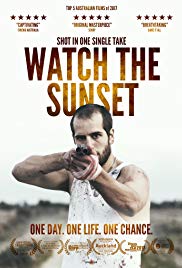
WATCH THE SUNSET
Australia, 2017, 78 minutes, Colour.
Tristan Barr, Chelsea Zeller, Michael Gosden.
Directed by Tristan Barr.
This is a small story which begins in Melbourne, travels through the Victorian countryside to the town of Kerang. In terms of technique, the film is something of a tour-de-force, the whole narrative filmed in one take. The director also indicated that everyone participated in a full rehearsal which was actually filmed just in case anything went wrong with the fully professional filming the next day.
While the film has action, there are long periods of quiet, of driving and focus on the drive, on the passing countryside, enabling audiences to reflect on what they are seeing – which, of course, involves the danger of the audience which is desperate for action to opt out or find these sequences tedious.
The opening is strong, a collage of footage about the drug culture, addicts, treatments, newspaper and television reports about those caught up in the drug world.
It emerges that one of these is the driver of the car, played by Tristan Barr who also collaborated in the screenplay and is the director. He has rescued a young woman, an addict, and drives her to the country town to place her in a motel and get away from the drugs.
There is an unexpected sequence in the town after the driver has sequestered the woman. He goes to the local church and listens to the choir. This leads to some considerable drama because one of the women in the choir is his wife who goes to pick up her daughter from school. The audience feels the tension between husband and wife, a mixture of desperation and love, arguments and regrets, intimations of hope.
The tension actually mounts as the wife’s brother and his friends, ideologically committed to the drug culture, abduct the daughter, exert standover tactics, especially concerning money.
There is a buildup to violence.
While the subject material is familiar, it is presented with a vigour as well as the intensity of the continuity of the single take.
There is a sunset at the end and a conclusion that might not have been expected or hoped for.
1. A small budget feature? The significance of the single take? The cast? Editing? The musical score?
2. The sequences of Melbourne, the heroine and ice addicts? Graphic? Driving the Victorian countryside, the town of Kerang, the motels, church, the yard, houses?
3. The title, whether addicts would reach the sunset? A life and fate? Choices?
4. The impact of the initial footage?
5. The girl, the influence of the drugs, out of it, in the back of the car, Danny driving, the long take of the drive, arriving in the town, depositing her in the motel?
6. Danny, his character, drug background, moving out, getting the girl, delivering her to the motel? Indications of his personality? Going to the church, at the back, Sally in the choir, her walking out, his confronting her, her collector her daughter from school, upset with the teacher? Danny taking his wife and daughter? The discussions, her going to play, her being abducted by her uncle? The pursuit, finding the address, collecting the addicted girl, in the back of the car, her getting the rifle? At the house, confronting Shane, his talking ideology of belonging to the group? Is associate and violence? The girl, her being abused in the past, her being shot? The confrontation with Danny, the gun to his head, Sally shooting her brother? The escape? Take his daughter, the rescue, promising the holiday? The current pursuit, the shots? Danny’s emotions throughout the day? Sending his wife and daughter ahead, dying on the road?
7. Sally, her past life, marriage, her daughter? Separation from Danny? Caught up in the action, the abduction of her daughter, the final shooting?
8. Her brother, the addicts, their code, brutal?
9. The style of the film, slow-moving, subdued sound times? The claim, audiences identifying with characters and plot, drug issues, emotional identification? Learning?